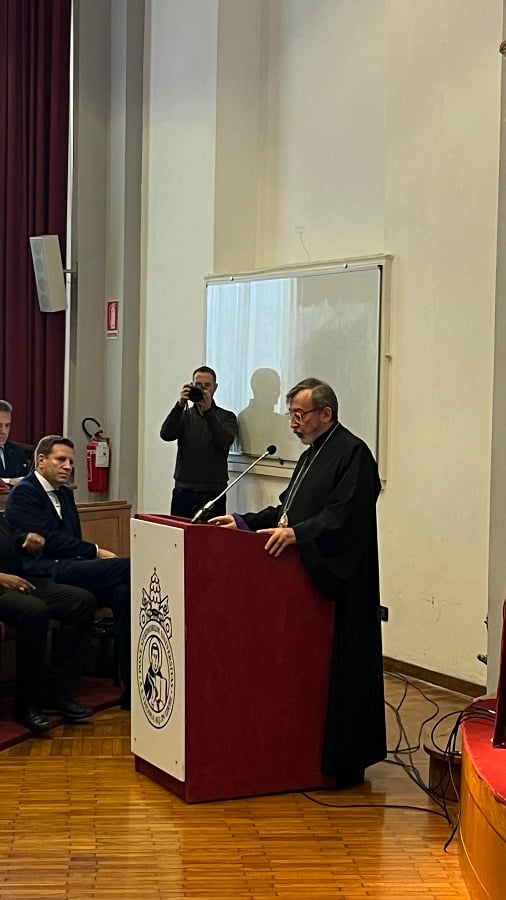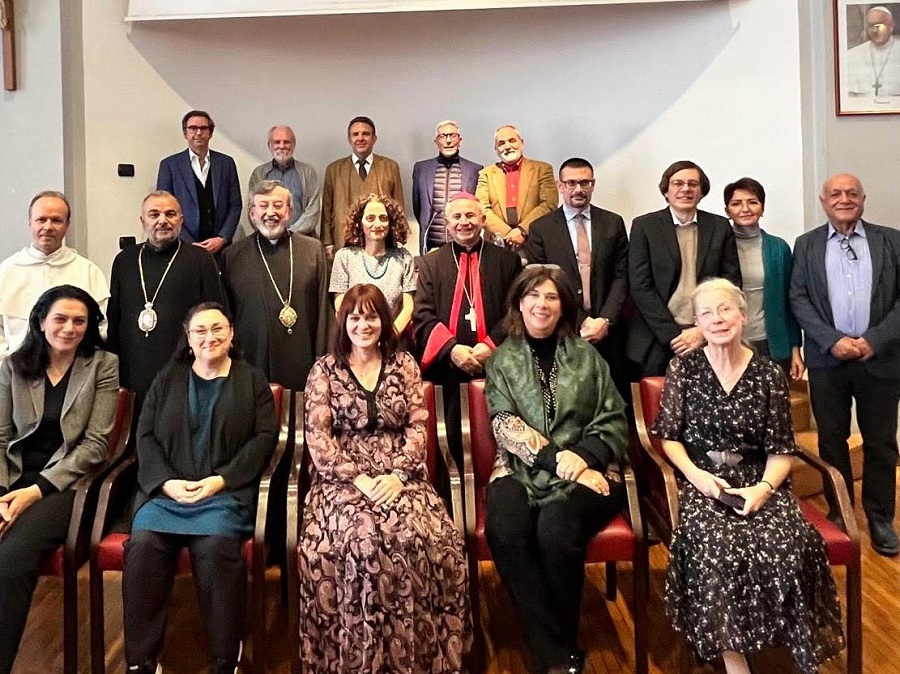Rome, Italy – On November 18 and 19, the Pontifical University of St. Thomas Aquinas (Angelicum) hosted the conference titled “Sacred Grounds, Shared Vision: Preserving Holy Sites for a Joint Christian Ministry of the Religious and Cultural Sites in Artsakh.” Organized by the Representation of the Armenian Apostolic Church to the Holy See and the Institute of Ecumenical Studies at Angelicum, the event received patronage from the Catholicosate of All Armenians and the Dicasteries for Promoting Christian Unity and the Culture and Education. It was financially supported by the Gulbenkian Foundation in Lisbon, Portugal.
The conference commenced with welcoming remarks from Father Hyacinth Destivelle, Director of the Institute of Ecumenical Studies, and Archbishop Khajag Barsamian, the Representative of the Armenian Church to the Holy See. Their addresses set the tone for an impactful dialogue on the cultural heritage of Artsakh and its significance in the broader Christian narrative and universal cultural rights.
Messages of support underscored the importance of the conference, with notable contributions from His Holiness Catholicos Karekin II, Cardinals Kurt Koch, Claudio Gugerotti, and Jose Tolentino de Mendoça. These messages of unity and commitment to preserving religious sites resonated throughout the proceedings.
The first section of the conference focused on the “Introduction of Cultural Heritage, Religious Sites, and Human Rights.” Esteemed experts, including Prof. Mark Vlasic from Georgetown University, Prof. Pierre D’Argent of Louvain University, and Armine Aleksanyan, a member of the Diocesan Council of Artsakh, made significant presentations. They addressed the intersection of cultural heritage and human rights, highlighting the urgent need to protect religious sites in conflict zones as a fundamental human right.
As discussions unfolded, participants emphasized that the preservation of these sacred places is not only vital to Armenian heritage but also crucial for the shared vision of a peaceful and unified Christian and more generally human community.
Read also
The second section of the conference provided an insightful examination of the intricate relationships between conflict, cultural heritage, and media representation, emphasizing how media narratives shape perceptions of cultural destruction and resilience. Prof. Vasco La Salvia from the University of Chieti opened the discussions with a compelling presentation on the destruction of cultural heritage as a byproduct of conflict. He highlighted how targeted attacks on cultural sites often serve as a means of erasure, reflecting deeper discriminatory practices that aim to diminish the identity of affected communities. This destruction not only leads to the loss of artifacts but also creates a rift in the collective memory and history of societies.
Complementing this presentation, Prof. Arsen Saparov from the Rabdan Academy addressed the role of the media in perpetuating silences and biases in reporting on cultural heritage destruction. He explored the notion of presumed neutrality in media and experts’ coverage, challenging the idea that media or experts can remain impartial in the face of ongoing conflicts. Instead, he argued that media narratives and expert opinions often reinforce existing power structures while silencing marginalized voices, thereby contributing to further discrimination and societal fragmentation.
In the third session, Archbishop Mikael Moussa Najeeb emphasized the ecumenical dimension of preserving cultural heritage, asserting that efforts to protect cultural sites must transcend religious divisions. He stressed the importance of collective stewardship in safeguarding heritage as a shared human responsibility. Following him, Prof. Peter Petkoff from Oxford University addressed the politically charged factors that lead to the weaponizing of religious and cultural heritage, revealing how geopolitical agendas can manipulate cultural symbols for consolidation of power.
Finally, Dr. Tasoula Hedjitofi presented a reflective strategy for Artsakh, drawing on 50 years of lessons learned from the conflict in Cyprus and her continuous activism in this domain. Her insights underscored the need for proactive cultural preservation strategies that engage local communities, promoting resilience in the face of adversity.
Overall, the sessions highlighted the complex interplay between conflict, cultural heritage, and media representation, advocating for a deeper understanding and commitment to preserving cultural identities amidst vulnerability.
The fourth session of the conference on Endangered Armenian Monuments, brought together a distinguished group of scholars to discuss the unique value as expressions of human creativity and the critical state of Armenia’s cultural heritage. Prof. Heghnar Watenpaugh from the University of California, Davis, initiated the discussions by addressing “The Fate of the Armenian Cultural Heritage of Nakhichevan: A Grim Potent for Artsakh?” Her presentation highlighted the dire implications of cultural erasure in Nakhichevan, setting a worrying precedent for the preservation of Armenian monuments in Artsakh. Following Prof. Watenpaugh, Prof. Jasmine Dum-Tragut from the University of Salzburg presented on the topic of “Cultural Heritage in Border Zones,” drawing upon examples from the Tavush region. Her insights emphasized the precarious situation faced by cultural sites in volatile geopolitical landscapes, suggesting that border zones often become battlegrounds for identity and cultural memory. Prof. Alain Navarra de Borgia of the Hyestart NGO further contributed to the discussion with his presentation on “Religious Sites and Shared Cultural Memory in Artsakh.” He underscored the importance of religious monuments as repositories of cultural identity, particularly in a region marked by conflict and changing power dynamics.
The fifth and the final session of the conference shifted the focus to the endangered cultural and religious heritage of Artsakh itself. Insights were offered by several experts, beginning with Prof. Marco Bais from the University of Rome La Sapienza and Pontifical Oriental Institute, who discussed the “Use and Abuse of Classical and Medieval Sources about Caucasian Albania.” His examination revealed how historical narratives can be manipulated to undermine Armenian claims and rights to heritage.
Prof. Jost Gippert of the University of Hamburg addressed “Albanian Inscriptions in Artsakh,” enhancing the discourse on historical legitimacy and laying the groundwork for reassessing inscriptions within the larger context of Armenian heritage.
Prof. Annegret Plontke-Lüning from the University of Jena rounded up the presentations by providing a historical overview of the “Architectural Heritage of Artsakh”—highlighting its richness and the urgent need for its protection. Finally, Prof. Hamlet Petrosyan of Yerevan State University presented on the “Monuments in the Armenian Azerbaijani Conflict Zone,” discussing identity, protection, and the importance of professional experience in safeguarding these historical treasures.
At the end, a round table discussion was facilitated by Prof. Zara Pogossian (University of Florence) and Prof. Marco Bais.
These discussions led by distinguished scholars regarding the cultural and architectural heritage of Artsakh illuminate the complexities surrounding identity, heritage preservation, and the ongoing Armenian Azerbaijani conflict.
Together, these scholars provide a compelling narrative that illustrates the rich cultural tapestry of Artsakh, while also highlighting the inherent risks faced by this heritage due to the unresolved conflict.
As the conference concluded, participants expressed renewed hope and commitment to the collective efforts needed to protect the sacred sites of Artsakh. The discussions ignited a collaborative spirit among attendees, serving as a solemn reminder of the fragility of cultural heritage in the face of conflict.
The organizing committee extends its gratitude to all the participants and speakers who graced the conference with their wisdom, advocating for a shared vision in the preservation of our sacred grounds.
Pontifical Legation Western Europe






















































